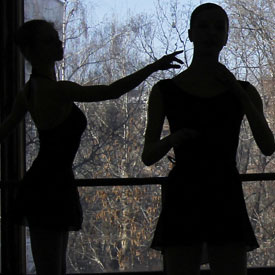Ballet dancers: under pressure, and underweight
A top Italian ballet dancer has been fired by her company after highlighting the dangers of anorexia – as young dancers are pressured to strive for the perfect body.

The leading dancer, Mariafrancesca Garritano, has been dismissed by La Scala opera house in Milan after she claimed that one in five ballerinas suffered from eating disorders like anorexia.
The 33-year-old said the illness was rife throughout the ballet world, but was rarely discussed: “It’s as if there is a Mafia code of omerta (silence) that rules over us and as (a) result it must never be broken.”
She told reporters that her own weight had dropped to just 43 kilos as a young teenager, yet teachers still told her she was fat and should lose weight if she wanted to get selectd for performances. And, she went on, “I know dancers who would compete against each other to see how little they could eat, which is lunacy.”
Now Ms Garritano has been fired for “damaging the image” of La Scala. Their spokesman, Carlo Maria Cella has denied the claims, insisting that kind of pressure was a thing of the past.
Size zero mentality
But in a profession which demands an asthetic of extreme thinness, along with a punishing physical regime, stories of young girls driven to disordered eating are not hard to find. David Kinsella’s documentary A Beautiful Tragedy, charted the “size zero” mentality of Russia’s ballet schools, where girls were told to maintain dangerously low body weights, which might land them in hospital over here.
One young dancer he featured, a teenage anorexic, now dances with the Mariinsky Theatre. One can only hope her health is now under control.
And the fitness trainer Robert Brace, who danced with New York’s Met and the Alvin Ailey company in the 1990s, told E Online about the regime adopted by the actress Natalie Portman as she readied for her role in Black Swan – a regime which mirrored real life.
“There are a lot of food and calorie restrictions, lots of coffee and cigarettes to keep the weight down… Training at that level and not eating and trying to continue to push your body in that way, you will break down psychologically,” he said.
New model army
In the modelling world, where the size zero debate has brought some of the issues around food and health out into the open, models themselves have been campaigning for better protection. Like dance, it is an industry which plunges very young girls into highly pressured, competitive situations, where they are continually judged by their body shape and appearance.
Today former model and activist Sara Ziff launched The Model Alliance in the United States, to improve basic working conditions and give models a proper voice.
I met a lot more bulimic girls (doing ballet)… It’s horrible. Anna Zanovello, model
“How the industry treats its models influences the ideal presented in these magazines, and these images have a powerful, far-reaching effect on women in general,” her mission statement says,
Here in the UK, supermodel Erin O Connor established the Model Sanctuary during London Fashion Week, to provide “discreet health guidance and educational support”. However this year, she has had to close it down after unsuccessfully trying to find new premises.
One of this year’s models-of-the-moment, Anna Zanovello, came to the world of fashion from ballet – and made some unfavourable comparisons last month in New York magazine: “I met a lot more bulimic girls (doing ballet)”, she said. “I think it’s worse in ballet because they check your weight and if you’re above a certain weight, you leave the school. It’s horrible.”
Ultimate extreme
And like models, dancers can be driven to the ultimate extreme. Boston Ballet dancer Heidi Guenther died at the age of 22 after suffering from anorexia, although a court rejected a bid by her parents to sue the company for wrongful death.
The price you pay is an unnaturally low weight. And the price you pay for that is disordered eating. Professor Julia Buckroyd.
Hertfordshire University professor Julia Buckroyd, who has written a book about eating disorders in the dance world, says the basic problem in both industries is the asthetic of extreme thinness.
“The technical demands have outrun the capacity of the ordinary body. The price you pay is an unnaturally low weight. And the price you pay for that is disordered eating.”, she told Channel 4 News.
It is all made worse by the mental and physical demands of constant training, in an environment which can be highly toxic to anyone already struggling with low self esteem, says Professor Buckroyd. And she said although there have been some improvements, like classes on nutrition, there has not been anywhere near enough change from within since she first started working in the field back in 1984. “If anything, the asthetic has become more extreme”.
Professional ballet is all about striving for perfection, especially the perfect body, and former dancers have begun speaking more openly about their struggle to cope. Eating discorders might be ballet’s dirty little secret, but it’s a secret that’s becoming far more well known.
Mariafrancesca Garritano told the Observer back in December that she cared deeply about La Scala: there was a chance she could get fired, she said, but she still really hoped things would change.